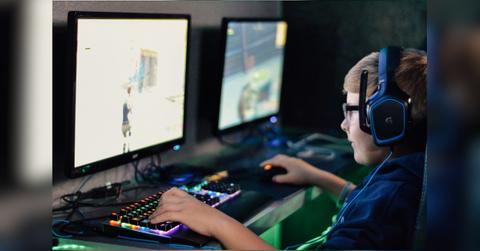 NEWS
NEWSRetro Revival: Why Old Games Are Beating New Releases

Aug. 12 2025, Published 1:30 a.m. ET
In an industry defined by cutting-edge technology and blockbuster innovation, it may seem counterintuitive that decades-old games are outperforming many of today’s newest releases — not just in player engagement, but in cultural relevance, community growth, and even commercial success.
Yet in 2025, the so-called “retro revival” is more than a trend. It’s a movement. Whether it’s fans revisiting the pixelated charm of EarthBound, developers remastering Resident Evil 4 for the umpteenth time, or streamers drawing massive audiences playing Super Metroid, one thing is clear: old games are not only surviving — they’re thriving.
What’s driving this unlikely resurgence? A combination of simplicity, soul, and a growing dissatisfaction with modern gaming's bloat. As seen in recent gaming updates from etruesports etruegames, more players are embracing the past not just out of nostalgia, but because the past still delivers what the present often struggles to.
The Beauty of Simplicity
Older games were often built under strict technical limitations — limited memory, slower processors, smaller teams. Ironically, those constraints fostered some of the most iconic game design in history. Games like Tetris, Mega Man, and Super Mario World emphasized clarity, balance, and tight mechanics. They had to be engaging without needing complex tutorials or elaborate systems.
In contrast, many modern titles bombard players with sprawling tutorials, layered monetization schemes, or bloated mechanics that bury the core gameplay under complexity. For gamers seeking instant fun or a challenge without the noise, retro titles offer a cleaner, more distilled experience.
There’s also a renewed appreciation for readability — visually and mechanically. Retro titles often feature intuitive layouts, recognizable assets, and clear objectives. The learning curve is steep in skill, not in system mastery, making them more accessible and rewarding to replay.
Authenticity Over Hype
While many new releases promise the world, they sometimes underdeliver. Incomplete launches, broken mechanics, and day-one patches have soured the excitement around many high-profile games. Contrast that with retro titles that “just worked” — cartridges and discs with fully formed, final products that stood the test of time.
Gamers today value authenticity more than ever. There's a growing sentiment that older games were built with passion, not profit as the primary motivator. That sense of care is palpable, whether in handcrafted sprite art or soundtracks composed with technological ingenuity. It’s not that older games are inherently better — it’s that they feel more honest.
Modding, Remastering, and Remakes
Another driver behind the retro resurgence is the modern effort to breathe new life into old favorites. Remastered editions, like Final Fantasy Pixel Remaster or Metroid Prime Remastered, offer cleaned-up visuals and smoother controls without tampering with core gameplay.
Meanwhile, the modding community has taken retro titles to new heights. Fan-made expansions, difficulty patches, or complete overhauls extend the life of classic games far beyond their original intent. In some cases, mods even outperform the publisher's own remakes.
There’s also a growing catalog of spiritual successors and indie tributes that lean heavily into retro aesthetics and mechanics. Titles like Shovel Knight, Axiom Verge, and The Messenger proudly emulate their 8-bit and 16-bit predecessors — often surpassing modern AAA games in innovation and heart.
Preserved and Playable
Accessibility has played a massive role in the retro revival. Thanks to widespread emulation, mini consoles, cloud gaming, and official digital storefronts, it's easier than ever to access classic titles across devices. Whether you’re playing on your phone, a modern console, or a handheld emulator, retro gaming is no longer locked behind vintage hardware or dusty cartridges.
This convenience has made it possible for a new generation of players to discover what earlier generations grew up with. Many of these newcomers find that, despite their age, retro games feel surprisingly modern — sometimes more so than bloated open-worlds or microtransaction-heavy shooters.
Community Keeps It Alive
The retro community is one of the most passionate and active corners of gaming culture. From speedrunners breaking records on Super Mario 64 to YouTubers analyzing the design of Castlevania: Symphony of the Night, there's a rich, thriving conversation surrounding classic games.
Social platforms have only amplified this. Retro gaming channels, Reddit communities, and Twitch streams pull in huge numbers. For many, watching someone tackle a difficult NES title or uncover secrets in Chrono Trigger is just as entertaining — if not more — than viewing the latest AAA release.
This community enthusiasm helps fuel both preservation and innovation. It ensures retro games aren’t just remembered — they’re played, shared, and celebrated every single day.
Want OK! each day? Sign up here!
A Pushback Against Modern Excess
In many ways, the retro revival reflects broader cultural fatigue. Players are tired of battle passes, live-service pressures, and overwhelming open worlds. Retro gaming provides an alternative — a return to finite, focused, and player-respecting experiences.
Where modern games often aim for endless engagement loops, retro titles deliver closure. You can beat Donkey Kong Country in a weekend. You can complete Link’s Awakening without needing a wiki. These aren’t forever-games; they’re memorable, complete journeys.
And that sense of completion — of something finished and satisfying — is increasingly rare in today’s gaming landscape.
Rediscovering the Roots of Fun
As we look ahead, the retro revival isn't just about remembering where gaming came from. It’s about redefining what good gaming feels like. It reminds us that fun doesn’t require photorealism or a $200 million budget. It can come from a 2D platformer with tight controls, or an 8-bit RPG with unforgettable music.
New games will always push boundaries — and they should. But if older titles continue to outperform their modern counterparts in player satisfaction, engagement, and even longevity, it may be time to admit: the past still knows how to play.


